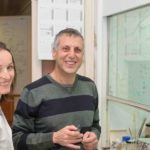
October 24, 2016
New Weizmann Institute of Science research just published in Cell Metabolism and reported in the Times of Israel plus other media, has found that changes in surrounding oxygen levels can reset circadian clocks of mice. If confirmed in humans, the research could help inform how airlines moderate cabin air pressure.
Understanding jet lag has been a puzzle for a while. Many biological processes follow a set timetable, with levels of activity rising and falling at certain times of the day – known as circadian rhythms, driven by biological ‘clocks’ based on an approximately 24-hour period.
The body’s master circadian clock, residing in the brain, synchronizes a multitude of peripheral clocks present in every single cell. Disruption to this optimum timing system in both animal models and humans can cause imbalances, leading to diseases like obesity, metabolic syndrome and fatty liver, among others. Presently, light, eating times and temperature are the major timing cues that synchronize circadian rhythms.
Dr Gad Asher of Weizmann’s Biomolecular Sciences Department and colleagues wondered if oxygen might also influence circadian rhythms, since oxygen absorption in animals is linked with nutrient ingestion and maintenance of body temperatures.
The researchers showed that changing the concentration of oxygen in cells by just three percent, twice a day, will reset mouse cells’ circadian clocks. They also suspected that a protein called HIF1α, which responds to changes in oxygen levels as well as playing a critical role in oxygen homeostasis in cells, was involved. Indeed, they found that cells deficient in HIF1α fail to synchronize in response to oxygen variations, providing evidence that HIF1α is the molecular link between changes in oxygen levels and the resetting of circadian clocks.
“It was extremely exciting to see that even small changes in oxygen levels were sufficient to efficiently reset the circadian clock,” said Dr Asher.
“The study actually raises a lot of important questions; although we show that clock reset by oxygen is dependent on HIF1α, we did not yet fully identify how HIF1α integrates within the core clock circuitry.”
The researchers further explored oxygen’s effect on circadian rhythms with jet lag experiments. Just like humans, mice are prone to jet lag after a sudden shift in daylight hours. Mice were left to eat, sleep and run on their wheels in oxygen-controlled environments.
Altering oxygen levels during their normal sleep-wake cycle did not change their circadian rhythms, but once mice experienced a six-hour jump ahead in daylight hours, varying oxygen levels could help them adapt their eating, sleeping and running habits to the new time faster.
For example, the scientists saw that a small drop in oxygen levels 12 hours prior to the six-hour daylight shift, or two hours afterwards, put the mice back on their circadian schedules faster. This, too, was dependent on HIF1α levels.
Presently, commercial airliners pressurize cabins to the same air density of a city 6,000-8,000 feet above sea level. This low-pressure saves wear and tear on the airplane, but enough passengers suffer from airsickness in response to this drop in oxygen levels that some airlines are considering ways to increase the pressure on flights. In fact, Boeing designed its new 787 Dreamliner so that it can be pressurized to the equivalent of lower altitudes for this reason.
In light of these findings, the researchers note that although passengers may feel better with higher pressurized cabins during flights, they may lose the potential advantage of recovering from jet lag. Now they want to test how higher oxygen levels may affect the circadian clock.
“We are very looking forward to seeing the outcome of these experiments – it will be interesting both from a basic science and a practical standpoint,” said Dr Asher.
“I believe passengers might be more enthusiastic to inhale oxygen-enriched air to alleviate jet lag in contrast to low oxygen.”
Understanding how oxygen influences the circadian clock goes beyond jet lag. Cardiovascular disease, COPD, shift work sleep disorder and other common health problems can result in tissues with low oxygen levels.
“We show that oxygen works in mammals, specifically rodents, but it will be interesting to test whether oxygen can reset the clock of bacteria, plants, flies and additional organisms,” Dr Asher concluded.






